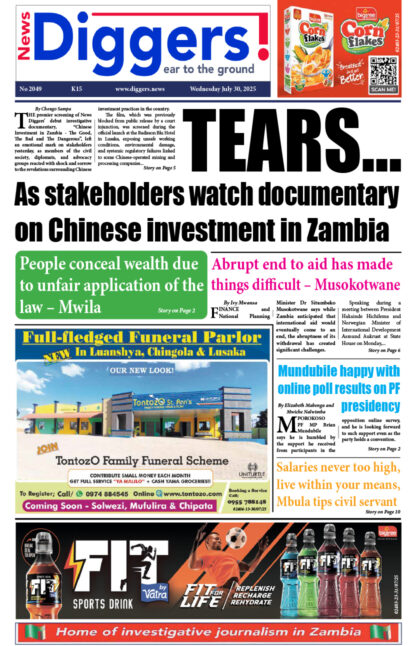KONKOLA Copper Mines Plc (KCM) now owes Copperbelt Energy Corporation (CEC) an outstanding US $150 million electricity bill, up from around US $144 million at the end of June, 2020.
And CEC managing director Owen Silavwe says CEC is currently doing “reasonably well” because in spite of the ongoing challenges it continues to face with KCM and Zesco Limited, prospects for growth remain strong.
Meanwhile, CEC chief financial officer Mutale Mukuka announced that the Kitwe-based power utility is progressing well with its market consolidation and further expansion into the Democratic Republic of Congo (DRC), leading to a 25 per cent sales volume increase last year.
Addressing questions from CEC shareholders during the company’s inaugural virtual Annual General Meeting (AGM) live from their Kitwe offices, Wednesday, Silavwe disclosed that KCM now owed the power utility US $150 million in unpaid electricity bills, a situation that remained problematic for the company’s operational performance this year.
CEC posted a loss of nearly US $32.5 million for its half-year period ending June 30, 2020, mainly triggered by KCM’s failure to settle its outstanding debt owed to the former.
Since the lapse of its Power Supply Agreement (PSA) with the mine in May, KCM, under provisional liquidation, has insisted to receive electricity directly from Zesco under a separate Agreement, but paying a lower tariff.
“First of all, between CEC and KCM, really, there should be no conflict because CEC supplied power to KCM, and KCM owes CEC money. However, as a company, we can’t determine how KCM behaves, and what is important for us is that we supplied power based on a contractually binding document, which was the PSA. And based on the obligations of the parties, KCM owes CEC money. So, what one would expect in a decent society is that KCM should own up and, if they have challenges, they would come through and explain what the challenges are and how they would want CEC to help them. That’s not what has happened, unfortunately. Therefore, as a company, we find ourselves in a situation where we have to find means and ways of getting that matter resolved because, remember, we are talking about US $145 million, which has now escalated to US $150 million and the vast majority of that money actually belongs to Zesco,” Silavwe disclosed.
“So, ideally, we should be sitting on the same side with Zesco. However, as we all know, at the moment, government is really controlling KCM and there could be some compelling reasons why Zesco in this case would not be pushing KCM to pay for that money. So from our perspective, basically, we’re asking KCM to meet their obligations. I don’t see anything wrong with CEC doing what it’s doing.”
He also pointed out that Zesco should equally not be in any conflict with CEC and ought to work in harmony to iron out any challenges, which culminated in its Bulk Supply Agreement (BSA) lapsing on March 31, 2020.
“On the Zesco side, we had the BSA with Zesco, which lapsed on March 31, 2020. Again, there shouldn’t be any conflict between CEC and Zesco. If Zesco is not happy with the terms of that Agreement, it’s within their right to say, ‘they are not happy’ and then we all go as a negotiating party to try to renegotiate the terms in good faith. It’s not expected that Zesco, who we all understand has a dominant position, would then try and use the dominant position to force terms on any party in the sector, not just CEC, even if it’s a residential customer, it’s not expected that they would force terms on that customer. That’s why there are safeguards in terms of how stakeholders in the sector are supposed to behave. So, from a CEC perspective, we think with everybody acting in good faith, we should be able to resolve these matters,” he said.
On the other hand, Silavwe said CEC was currently doing “reasonably well” in spite of the ongoing challenges it continued to face with KCM and Zesco as prospects for growth remained strong.
“Now, obviously, things have moved on; the agreements that we had with Zesco and KCM are behind us. The big question is: how is the business protected? And I think it’s important that we do explain that. At the moment, in my assessment, the business is doing reasonably well in the sense that we have put in arrangements that should protect the business position of CEC because the power that KCM is consuming today is coming from Zesco. And under that scenario, the structure that has generally been looked at involves Zesco paying for the transmission services that CEC is providing, and then, KCM paying for what is mostly understood to be sort of ‘last mile’ services that CEC is providing to them. The challenge that we have got is putting those agreements in place. However, suffice to say that the business position is well looked after at the moment, and I think that the priority in 2020 is to get those agreements put in place to make sure that we’ve got a legally binding position,” said Silavwe.
Meanwhile, Mukuka told shareholders that CEC had established a base in the DRC, as the company sought to grow its market in that country.
“At the moment, the opportunity is still there – we have medium-term contracts with a number of customers in the DRC. We recently adopted a DRC Strategy; the MD mentioned in his presentation that we now have an office and the office is focused on marketing and account management, engaging with the customers there. So, the intention, really, is to see how we can continue to play a part in that market. The intention is to continue to grow in that market,” said Mukuka.
According to its 2019 Annual Report released ahead of the AGM, CEC’s total value contribution to the Zambian economy peaked at nearly US $2 billion over a five-year period ending December 31, 2019, with local suppliers having benefited the most, receiving over US $1.1 billion between 2015 and 2019.
“Our value creation and contribution to the economy over the five years reviewed exceeds US $1.9 billion, with the majority of this, at 72 per cent, contributed to suppliers and contractors, the Government of Zambia at US $193.0 million, our employees with whose skills we are able to deliver the services to our customers accounting for US $102.0 million, our shareholders having received US $108.0 million. US $34.0 million has gone to our financial partners, and our contribution to the communities via social investments stands at US $9.0 million,” read the report.



















